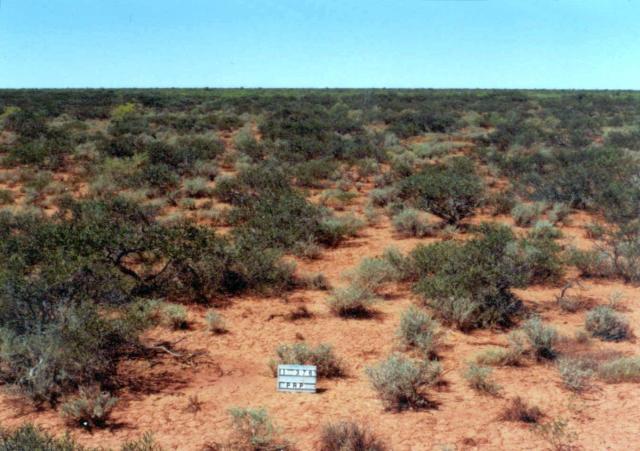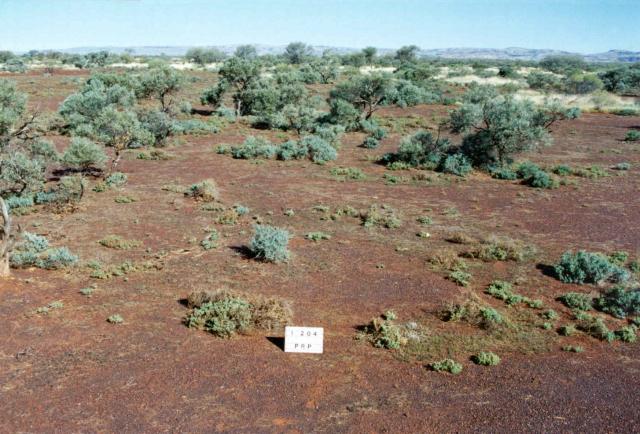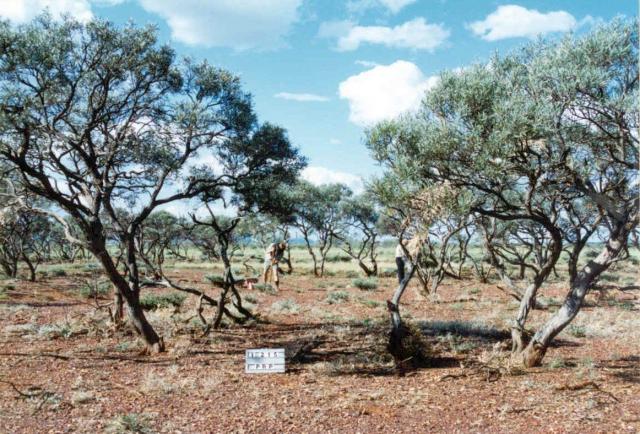Pasture potential
Snakewood chenopod pastures are of moderate pastoral value. The low shrubs include palatable species which are preferred by livestock and provide high quality feed in dry seasons. These are augmented by scattered perennial grasses and a range of forbs and herbs in season. Snakewood itself is a poor feed and grazed only as a last resort. Snakewood chenopod pastures in good condition can support all classes of stock on a year-long basis provided stocking rates are appropriate.
Suggested levels of use (per annum)
- Good condition: 80 hectares per cattle unit (ha/cu).
- Fair condition: 112 ha/cu.
- Poor condition: 160 ha/cu.
Managing snakewood chenopod pastures in the Pilbara
Grazing management
This preferred pasture type is prone to degradation. Management should aim at maintaining the productivity and vigour of the decreaser low shrubs. Grazing can be continuous for several years, but paddocks should be spelled occasionally for three to six months after good rains to maintain good condition. Pasture in poor condition may require spelling over consecutive growing seasons to improve condition.
Snakewood chenopod pastures often occur as small productive inclusions within less attractive pastures, which leads to it being preferentially grazed. In these circumstances, it is impossible to fence the snakewood chenopod pasture as a separate unit, and grazing on the preferred plants need to be carefully managed to prevent overgrazing.
Pasture condition
Traverse data (138 observations) during the Pilbara rangeland survey 1995–97 recorded:
Pasture condition: very good 7%, good 12%, fair 23%, poor 34%, very poor 24%.
Soil erosion: nil 74%, slight 9%, minor 7%, moderate 4%, severe 3%, extreme 3%.
The condition of snakewood chenopod pastures is variable but mostly poor, with moderate to substantial losses of decreaser species in many cases. Where the vegetation is severely degraded, soil erosion is common.
Very good – good condition
In good condition (Figure 1), nearly all snakewood shrubs will have three or four species of desirable palatable shrubs (e.g. silver saltbush, ruby saltbush, tall saltbush) growing around the trunks or under their canopies. Sparse tussocks of desirable grasses such as curly windmill grass (Enteropogon acicularis) also grow under the snakewoods. In addition, the inter-snakewood spaces support very scattered stands of low shrubs, with projected foliar cover of 2.5 to10%, some of which will be decreasers. There should be no soil erosion.

Fair condition
Snakewood chenopod pastures in fair condition (Figure 2) still supports decreaser shrubs under the snakewoods but populations are reduced to perhaps two or three individuals under each tree. The density of decreasers in the inter-snakewood spaces is reduced and may be replaced by marginal increases in less desirable shrubs such as cassias (Senna spp.).

Poor – very poor condition
Palatable shrubs and grasses are absent or occur only as occasional heavily grazed remnants under the snakewoods or in open spaces (Figure 3). The hardy decreaser tall saltbush (Rhagodia eremaea) is among the last to disappear under excessive grazing pressure. Forage is reduced to annual herbs and grasses in season and the pasture has no durability in dry times. Soil erosion is common.

Vegetation structure and composition
Snakewood chenopod pastures are characteristically a mid height (1–2 m) or tall (>2 m) shrubland of snakewood (Acacia xiphophylla) with a patchy understorey of chenopod shrubs (saltbush and bluebush of the family Chenopodiaceae), other low shrubs and a few perennial grasses. The low shrubs tend to be clumped beneath the protection of the taller snakewoods and are somewhat sparser in the inter-snakewood spaces. The overall density of shrubs is usually scattered to moderately close with projected foliar cover 10–25%.
Common low shrubs include silver saltbush (Atriplex bunburyana), sago bush (Maireana pyramidata), ruby saltbush (Enchylaena tomentosa), tall saltbush (Rhagodia eremaea), cassias (Senna spp.) and bindiis (Sclerolaena spp.).
Occurrence
This pasture type is found in southern and central parts of the Pilbara on alluvial and stony plains of land systems such as Christmas, Cowra, Hooley, Marillana, Narbung, Paraburdoo, Sherlock and Turee.
Soils are deep red-brown clays, loamy earths and deep duplexes, which often occur as a mosaic with cracking clay soils with gilgai microrelief surfaces. Stony surface mantles may or may not be present. The mosaic of soil types occurs in patches that may be 10m to more than 100m in extent, and the snakewood chenopod pasture is mostly confined to the non-gilgaied parts. The gilgaied surfaces usually support tussock grasslands of Roebourne Plains grass pasture or Mitchell grass alluvial plain pasture.
Snakewood chenopod pastures also occur over more extensive alluvial plains (such as in the Cane land system) where there is no gilgai development. Soils are deep red-brown clays, occasionally with a lighter surface of loam and the subsoil is usually semi-saline.
Associated plants
| Common name (link to DPIRD species page) | Scientific name (link to FloraBase) | Life form |
|---|---|---|
Decreasers (desirables) | ||
| Silver saltbush | Atriplex bunburyana | shrub |
| Cenchrus ciliaris | perennial grass | |
| Enchylaena tomentosa | shrub | |
| Curly windmill grass | Enteropogon ramosus (syn. Enteropogon acicularis) | perennial grass |
| Eragrostis xerophila | perennial grass | |
| Golden bluebush | Maireana georgei | shrub |
| Sago bush | Maireana pyramidata | shrub |
| Maireana tomentosa | shrub | |
| Sensitive plant | Neptunia dimorphantha | perennial herb or shrub |
| Senna hamersleyensis | shrub | |
| Creeping sida | Sida fibulifera | perennial herb or shrub |
Increasers (undesirables) | ||
| Triodia lanigera | perennial grass | |
| Triodia wiseana | perennial grass | |
| Straight leaf cassia | Senna sp. Meekatharra | shrub |
Intermediates | ||
| Three winged bluebush | Maireana triptera | shrub |
| Senna artemisioides subsp. oligophylla | shrub | |
| Variable cassia | Senna artemisioides subsp. sturtii | shrub |
| Bindiis | Sclerolaena spp. | shrub or perennial herb |
| Triodia pungens | perennial grass | |
No indicator value (stability desirables) | ||
| Curara | Acacia tetragonophylla | shrub or tree |
| Acacia victoriae | shrub or tree | |
| Snakewood | Acacia xiphophylla | shrub or tree |
| Royal poverty bush | Eremophila cuneifolia | shrub |
| White cassia | Senna glutinosa subsp. xluerssenii | shrub |
Other resources
van Vreeswyk, AM, Leighton, KA, Payne, AL, & Hennig, P 2004, An inventory and condition survey of the Pilbara region, Western Australia, Department of Agriculture and Food, Western Australia, Perth. Technical Bulletin 92.

